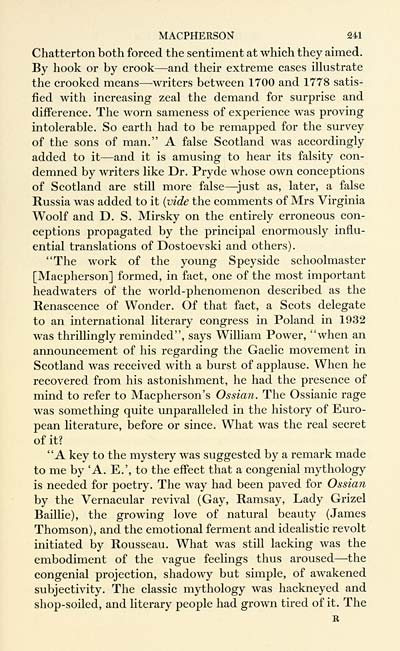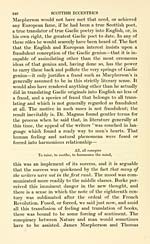Ossian Collection > Scottish eccentrics
(257)
Download files
Complete book:
Individual page:
Thumbnail gallery: Grid view | List view

MACPHERSON 241
Chatterton both forced the sentiment at which they aimed.
By hook or by crook — and their extreme cases illustrate
the crooked means — writers between 1700 and 1778 satis-
fied with increasing zeal the demand for surprise and
difference. The worn sameness of experience was proving
intolerable. So earth had to be remapped for the survey
of the sons of man." A false Scotland was accordingly
added to it — and it is amusing to hear its falsity con-
demned by writers like Dr. Pryde whose own conceptions
of Scotland are still more false — just as, later, a false
Russia was added to it (vide the comments of Mrs Virginia
Woolf and D. S. Mirsky on the entirely erroneous con-
ceptions propagated by the principal enormously influ-
ential translations of Dostoevski and others).
"The work of the young Speyside schoolmaster
[Macpherson] formed, in fact, one of the most important
headwaters of the world- phenomenon described as the
Renascence of Wonder. Of that fact, a Scots delegate
to an international literary congress in Poland in 1932
was thrillingly reminded", says William Power, "when an
announcement of his regarding the Gaelic movement in
Scotland was received with a burst of applause. When he
recovered from his astonishment, he had the presence of
mind to refer to Macpherson's Ossian. The Ossianic rage
was something quite unparalleled in the history of Euro-
pean literature, before or since. What was the real secret
of it?
"A key to the mystery was suggested by a remark made
to me by 'A. E.', to the effect that a congenial mythology
is needed for poetry. The way had been paved for Ossian
by the Vernacular revival (Gay, Ramsay, Lady Grizel
Baillie), the growing love of natural beauty (James
Thomson), and the emotional ferment and idealistic revolt
initiated by Rousseau. What was still lacking was the
embodiment of the vague feelings thus aroused — the
congenial projection, shadowy but simple, of awakened
subjectivity. The classic mythology was hackneyed and
shop-soiled, and literary people had grown tired of it. The
Chatterton both forced the sentiment at which they aimed.
By hook or by crook — and their extreme cases illustrate
the crooked means — writers between 1700 and 1778 satis-
fied with increasing zeal the demand for surprise and
difference. The worn sameness of experience was proving
intolerable. So earth had to be remapped for the survey
of the sons of man." A false Scotland was accordingly
added to it — and it is amusing to hear its falsity con-
demned by writers like Dr. Pryde whose own conceptions
of Scotland are still more false — just as, later, a false
Russia was added to it (vide the comments of Mrs Virginia
Woolf and D. S. Mirsky on the entirely erroneous con-
ceptions propagated by the principal enormously influ-
ential translations of Dostoevski and others).
"The work of the young Speyside schoolmaster
[Macpherson] formed, in fact, one of the most important
headwaters of the world- phenomenon described as the
Renascence of Wonder. Of that fact, a Scots delegate
to an international literary congress in Poland in 1932
was thrillingly reminded", says William Power, "when an
announcement of his regarding the Gaelic movement in
Scotland was received with a burst of applause. When he
recovered from his astonishment, he had the presence of
mind to refer to Macpherson's Ossian. The Ossianic rage
was something quite unparalleled in the history of Euro-
pean literature, before or since. What was the real secret
of it?
"A key to the mystery was suggested by a remark made
to me by 'A. E.', to the effect that a congenial mythology
is needed for poetry. The way had been paved for Ossian
by the Vernacular revival (Gay, Ramsay, Lady Grizel
Baillie), the growing love of natural beauty (James
Thomson), and the emotional ferment and idealistic revolt
initiated by Rousseau. What was still lacking was the
embodiment of the vague feelings thus aroused — the
congenial projection, shadowy but simple, of awakened
subjectivity. The classic mythology was hackneyed and
shop-soiled, and literary people had grown tired of it. The
Set display mode to: Large image | Transcription
Images and transcriptions on this page, including medium image downloads, may be used under the Creative Commons Attribution 4.0 International Licence unless otherwise stated. ![]()
| Early Gaelic Book Collections > Ossian Collection > Scottish eccentrics > (257) |
|---|
| Permanent URL | https://digital.nls.uk/81911428 |
|---|
| Description | Selected books from the Ossian Collection of 327 volumes, originally assembled by J. Norman Methven of Perth. Different editions and translations of James MacPherson's epic poem 'Ossian', some with a map of the 'Kingdom of Connor'. Also secondary material relating to Ossianic poetry and the Ossian controversy. |
|---|
| Description | Selected items from five 'Special and Named Printed Collections'. Includes books in Gaelic and other Celtic languages, works about the Gaels, their languages, literature, culture and history. |
|---|

